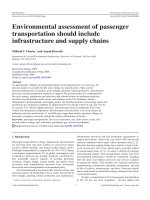Tài liệu The Theory of the Design of Experiments doc
Bạn đang xem bản rút gọn của tài liệu. Xem và tải ngay bản đầy đủ của tài liệu tại đây (154.03 KB, 2 trang )
Viewpoint
T
he teaching of evolution in Amer-
ican high schools is once again un-
der siege from creationists. The recent
court challenge in Kitzmiller et al. v.
Dover Area School District,
in York
County, Pennsylvania, is a case in point.
Almost everyone accepts the occurrence
of microevolutionary changes within
species, such as selection for mutated
genes that confer resistance in insects to
pesticides or in bacteria to drugs used to
treat disease (e.g., multidrug-resistant
strains of tuberculosis have become a
problem worldwide). Creationists, how-
ever, demand that biology teachers be
required to introduce the “theory of in-
telligent design”(ID) as an alternative to
the “theory of evolution”for explaining
the diversity of life on Earth and the ex-
istence of millions of different species.
Opponents of this view hold that ID is
not a scientific theory but a religious
doctrine that will violate the US Con-
stitution if taught in public schools.Vir-
tually all research biologists oppose the
cr
eat
ionist view, although many of these
same biologists provide creationists with
a target that serves to obfuscate rather
than illuminate the breadth and depth of
scientific support for evolution envi-
sioned as an unguided, self-organizing
process. The target I refer to is “the the-
ory of evolution.” It invokes the notion
of a single, refutable scientific theory
with a veracity that hangs on the correct
interpretation of the fossil record or on
some other narrowly construed set of
biological data.
From our current understanding of
the t
erm “scientific theory,”it is anachro-
nistic to use the phrase “theory of evo-
lution.”What constitutes a self-contained
scientific theory is a subject of much
philosophical hand-wringing. An ac-
ceptably succinct, although not author-
itative, definition of a scientific theory is
the following (online at
www.wikipedia.
org as of 2 December 2005):“In various
sciences, a theory is a logically self-
consistent model or framework for de-
scribing the behavior of a certain natural
or social phenomenon, thus either orig-
inating from observable facts or sup-
ported by them.” The theory of evolution
may have fit this definition 150, or even
75, years ago, but it no longer does.
Almost 150 years ago, Darwin pub-
lished his 1859 treatise on the origin of
species. His ideas were seminal for our
current view of evolution, but drew
extensively on the work of other early
19th-century scientists, particularly the
French zoologist Jean-Baptiste Lamarck.
Lamarck posited that individuals mod-
ify various traits during their formative
years as an adaptation to changing en-
vironmental conditions and then pass
on these adaptations to their progeny. By
focusing on the relative fitness of indi-
viduals, Lamarckian theory and Dar-
winian theory were constituted primarily
at a single level of analysis—that of the
indi
v
idual organism. Thus, both are
much closer to being “theories of evo-
lution”than current evolutionary theory,
which includes several self-contained
sets of statements framed at various
levels of analysis.
Current evolutionary theory under-
pins a scientific field of study supported
by all branches of biology, from molec-
ular genetics to ecology. Practitioners
address questions regarding the lineages
of molecules, genes, physiological and
behavioral adaptations, individuals, ex-
tended phenotypes, and species, with a
f
ocus on how the differential survival
and reproduction of individuals within
interbreeding groups leads over time to
the cr
eation of biological diversity.
Progress is made in this field by collect-
ing or generating genetic, physiological,
o
ntological, morphological, and behav-
ioral data from living, dead, and fos-
silized individuals, as well as develop-
ing theories at several different levels of
analysis. Among the most important ap-
plications of these theories is the use of
principles such as parsimony or maxi-
mum likelihood to construct phylo-
genetic trees that represent our best
understanding of lineage relationships
among extant and extinct species.
To get a clearer understanding of why
it is anachronistic to refer to all of this as
the theory of evolution, I suggest we
look to ecology—evolution’s sibling field
under the umbrella of population biol-
ogy. The term “ecological theory” is used
to refer to an array of theoretical frame-
works providing levels of ecological
analysis at the physiological, behavioral,
individual, community, landscape, and
regional scales of analysis, but no logi-
cally self-consistent “theory of ecology”
exists. In particular, the analysis of a
process at one ecological level produces
only partial insight into properties
emerging at some higher level. As a case
in p
o
int, an analysis of how organisms
forage to maximize their individual fit-
ness has failed, despite concerted efforts,
to produce a coherent theory of how the
average rate of food consumption per
capita at the population level is affected
by competition among individuals. The
lack of a unified “theory of ecology” and
the existence instead of a fragmented
body of “ecological theory”is evidenced
by the relative use of these two terms in
the scientific literature. For example, an
ISI Web of Knowledge online search in-
dicates that the phrase “ecological the-
o
ry” appears 15 times more often than
the “theory of ecology”: a search on 5
January 2006 yielded 568 entries for the
f
ormer but only 37 for the latter.
A concurrent search using the word
“evolution”in place of “ecology” yielded
1366 and 578 e
ntries, respectively: that is,
the phrase “evolutionary theory” is used
The “Theory of Evolution”
Is a Misnomer
WAYNE M. GETZ
96 BioScience • February 2006 / Vol. 56 No. 2 www.biosciencemag.org
www.biosciencemag.org February 2006 / Vol. 56 No. 2 • BioScience 97
Viewpoint
only 2.4 times more frequently than “the-
ory of evolution”in the scientific litera-
ture. Why does the phrase “theory of
evolution”appear nearly 16 times as fre-
q
uently as “theory of ecology” in the sci-
entific literature covered by the ISI Web
of Knowledge, while the phrases “theory
of evolution” and “ecological theory”
appear with almost equal frequency ?
The reasons appear strongly historical.
Evolution, as propounded by Lamarck
and then by Darwin, was regarded as a
coherent theory explaining the origins of
biological diversity. Ecology, on the other
hand, started out as a field of study first
defined by Ernst Haeckel, in the mid-
19th century, as the study of the rela-
tionship between organisms and
environment, and a century later by An-
drewartha and Birch (1954) as the study
of the distribution and abundance of
organisms.
Today certain specific theories of evo-
lution, such as Lamarckian evolution,
ha
ve been largely discredited. Others,
such as intelligent design, have been de-
bunked as unscientific (whatever the
outcome of past or future court cases
on the content of school biology texts).
A few hold considerable credence but
are diminishing in importance. The neu-
tral theory of evolution falls into this
latter category: it is used, among other
things, to explain the existence of large
amounts o
f
so-called junk DNA, but
some of this DNA now appears to have
a biological function.
Many biologists may argue that the
modern synthesis—the mid- to late-
20th-century elaboration of Darwin’s
exposition of evolution by natural se-
lection in terms of mutable, heritable
genetic traits at the individual level—is
sufficiently dominant to justify contin-
u
ed use of the phrase “the theory of evo-
lution.”But this dominance prevails only
because we continue to put too much
store in a gene-centric view of the evo-
lutionary process, despite our increasing
appreciation of the importance of the
evolution of epigenetic structures (e.g.,
methylation patterns in DNA) and the
operation of natural selection at the
demic (i.e., small subpopulation) and
species levels. Furthermore, the modern
synthesis lies uncomfortably within the
“levels of selection”debate and does not
account for, among other things, over-
lapping genes (different genes sharing
the same stretch of DNA), the emer-
gence of the eukaryote cells from sym-
biotic bacterial communities, the transfer
of genetic material by viral and bacter-
ial vectors among individuals belong-
ing t
o different species, or the appearance
of Lamarck’s ghost in the influence of the
environment on DNA methylation and
gene expression.
In conclusion, we population biolo-
gists should tighten up our terminology
and eschew the phrase “the theory of
evolution.” Granted, evolution is a the-
oretically more cohesive field than ecol-
ogy: Genes, the fundamental units of
e
v
olution, are uniquely defined in terms
of their base pair coding and, hence, are
exactly replicable at this structural level,
whereas individuals and populations—
the basic units of ecology—exhibit con-
siderable variation with environmental
influences, ensuring that even clones ex-
h
ibit physiological, morphological, and
behavioral differences. Unlike theories in
physics, however, evolutionary theories
are not based on mathematically pre-
c
ise laws of nature but on mathematical
descriptions of idealized systems from
which known complexities have been
excised. Thus no unifying “theory of
everything”lies just beyond the horizon
of evolutionary theory. By removing “the
theory of evolution”from our lexicon, we
ultimately ensure that the lay public is
not misled into believing evolution can
be discredited by a specific group of facts
that bear on only one facet of the sub-
stantial, scientifically entrenched body of
knowledge that constitutes the scientific
field of evolution.
Wayne Getz (e-mail: ) is
a professor and biomathematician in the
Department of Environmental Science, Policy, and
Management at the University of California,
Berkeley, CA 94720.
Acknowledgments
I would like to thank Annaliese Beery,
John Eppley, Holly Ganz, James Lloyd-
Smith, Sadie Ryan, Maria Sánchez, Karen
Weinbaum, and George Wittemyer for
comments that have greatly improved
this article.
Reference cited
Andrewartha HG, Birch LC. 1954. The Distribu-
tion and Abundance of Animals. Chicago:
U
ni
v
e
r
sity of Chicago Press.
B
ac
k cover photo credits:
Spir
aling ou
tward from upper left, diatom, Mark B. Edlund, NSF Image Library; salmon, Gary Kramer, USDA Nat-
ural Resources Conservation Service (NRCS); foxes, Gary Kramer, USDA NRCS; burrowing owl, Gary Kramer, USDA NRCS; contoured
field, Tim McCabe, USDA NRCS; red-eared turtles, Lynn Betts, USDA NRCS.
Inside front cover photo credits: Upper right, penguins, stock photo; bottom right, alfalfa plant bug, Scott Bauer, USDA Natural
Resources Conservation Service (NRCS); left, goldfish, Ron Nichols, USDA NRCS.
Inside back cover photo credits: Clockwise from upper right, wetlands, courtesy of USDA Natural Resources Conservation Service (NRCS);
bioluminescent je
l
lyfish, Osamu Shimamura, Marine Biological Laboratory at Woods Hole, Massachusetts, from NSF Image
Library; penguins, stock photo; contoured field and terraces, Jeff Vanuga, USDA NRCS.









